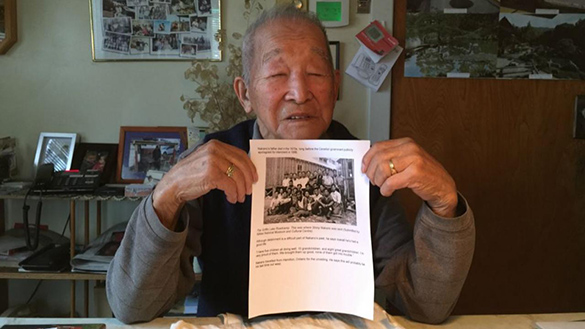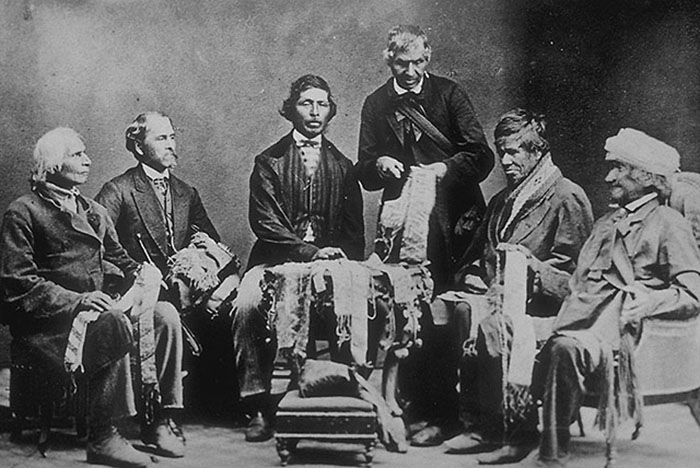Minds On
Exploring perspectives
When exploring different historical or contemporary events, it is important to explore a variety of perspectives about this event.
What is a perspective?
Press the 'Definition' button to reveal a description of a perspective.
Brainstorm
What do you think?
Consider the following questions:
- What would be the significance of exploring multiple perspectives?
- How would including various perspectives increase the understanding of an event?
- Why might people have a variety of perspectives about an event?
Diverse groups may experience the same development or event in different ways. This is known as having different perspectives.

Consider the following scenario
In a Grade 6 class in Ontario, students have been studying the diversity of Canada and have been asked to decide the most culturally significant building in their community.
- Why might people have a variety of perspectives on deciding which building is the most culturally significant?
- What might some of these perspectives be?
Complete the following Exploring Perspectives activity in your notebook or use the following fillable and printable document. If you would like, you can use speech-to-text or audio recording tools to record your thoughts.
| Why might people have a variety of perspectives about this? | What might some of these perspectives be? |
Press the ‘Activity’ button to access the Exploring Perspectives activity.
Action
Diversity in perspectives
Exploring multiple perspectives requires finding source materials that reflect different views of a historical event. In recent decades, scholars and educators have begun to question historical narratives that only share one perspective.
Instead of just focusing on dominant groups and communities, they recommend thinking about multiple perspectives.
One reason for this is that it is important to consider diversity and to make sure that those who have been ignored in traditional historical narratives have history told from their perspective as well.
Task 1: Perspectives in Canadian history

Select a topic from Canadian history to learn more about. These topics focus on significant events or developments and experiences of distinct communities, either contemporary or historical. Some topics have links provided to TVO articles and documentaries that may help you get started with your research. If not, it is important that you begin your search using websites, videos, audio recordings or print resources from the communities you are studying, Canadian encyclopedia websites, or Canadian museum websites.
Thinking critically about using websites
Websites ending with .com, .org, and .net can be purchased and used by any person. Be careful when using these websites, and ask yourself if these websites are credible or have bias. The ending .org is usually used by non-profit organizations, which may have an agenda of persuasion rather than education.
Websites ending in .edu are reserved for colleges and universities. Canadian websites have .ca endings. It is important to consider using credible Canadian websites for research when possible!
Canadian history topics and the groups involved
Choose one of the following Canadian history topics to research. Follow the steps discussed in the following sections for this assignment to gain more information about your topic. Be ready to share your research.
Be sure that your research explores the impact of this moment in history on the various groups of people involved.
The Development of the First Nations Reserve System- Consider the impact of this on Indigenous peoples, European settlers, and the federal government.
- Consider the impact of this on Japanese Canadians and the federal government.

Press tvo today to access "Honouring the Japanese Canadians Who Worked Ontario Farms During and After the Second World War."
Opens in a new tabThe Negotiation and Interpretation of Indigenous Treaties
- Consider the impact of this on Indigenous peoples and the federal government.
The creation of the Indian Act
- Consider the impact of this on Indigenous peoples and the federal government.
The Expulsion of the Acadians
- Consider the impact of this on the Acadians and the British government.

The Story of Africville
- Consider the impact on Black Canadians and the Halifax Government.

The Story of the Komagata Maru
- Consider the impact on Sikh Canadians and the federal government.

Step 1: Before research
For each topic, some guiding questions have been provided to help you get started with your inquiry and to ensure that you include multiple perspectives in researching your topic.
Complete one of the following Q-Chart: Research Organizer activities by brainstorming questions about your chosen topic in your notebook or using the following fillable and printable document. If you would like, you can use speech-to-text or audio recording tools to record your thoughts.
The development of the First Nations reserve system
If your chosen topic is the development of the First Nations reserve system, complete the Q-Chart: The Development of the First Nations Reserve System activity in your notebook or using the following fillable and printable document. If you would like, you can use speech-to-text or audio recording tools to record your thoughts.
Press the ‘Activity’ button to access Q-Chart: The Development of the First Nations Reserve System.
The forced relocation of Japanese Canadians during World War Two
If your chosen topic is the forced relocation of Japanese Canadians during World War Two (often shortened to WWII), complete the Q-Chart: The Forced Relocation of Japanese Canadians During WWII activity in your notebook or using the following fillable and printable document. If you would like, you can use speech-to-text or audio recording tools to record your thoughts.
Press the ‘Activity’ button to access Q-Chart: The Forced Relocation of Japanese Canadians During WWII.
The negotiation and interpretation of Indigenous treaties
If your chosen topic is the negotiation and interpretation of Indigenous treaties, complete the Q-Chart: The Negotiation and Interpretation of Indigenous Treaties activity in your notebook or using the following fillable and printable document. If you would like, you can use speech-to-text or audio recording tools to record your thoughts.
Press the ‘Activity’ button to access Q-Chart: The Negotiation and Interpretation of Indigenous Treaties.
The History of Africville
If your chosen topic is the history of Africville, complete the Q-Chart: The History of Africville activity in your notebook or using the following fillable and printable document. If you would like, you can use speech-to-text or audio recording tools to record your thoughts.
Press the ‘Activity’ button to access Q-Chart: The History of Africville.
The history of the Komagata Maru
If your chosen topic is the history of the Komagata Maru, complete the Q-Chart: The History of the Komagata Maru activity in your notebook or using the following fillable and printable document. If you would like, you can use speech-to-text or audio recording tools to record your thoughts.
Press the ‘Activity’ button to access Q-Chart: The History of the Komagata Maru.
The creation of the Indian Act
If your chosen topic is the creation of the Indian Act, complete the Q-Chart: The Creation of the Indian Act activity in your notebook or using the following fillable and printable document. If you would like, you can use speech-to-text or audio recording tools to record your thoughts.
Press the ‘Activity’ button to access Q-Chart: The Creation of the Indian Act.
The expulsion of the Acadians
If your chosen topic is the expulsion of the Acadians, complete the following Q-Chart: The Expulsion of the Acadians activity in your notebook or using the following fillable and printable document. If you would like, you can use speech-to-text or audio recording tools to record your thoughts.
Press the ‘Activity’ button to access Q-Chart: The Expulsion of the Acadians.
Student Tips
What is a questioning matrix?

A questioning matrix (or Q-Matrix) is a chart that helps learners create questions about the content of the text they are exploring.
A Q-matrix asks the questions who, what, when, where, how, and why along the top of the chart, and the following words in a column along the far left side: is, did, can, would, will, might. When a learner combines two of these words together, they become question starters.
A questioning matrix includes four kinds of questions: factual questions, predictive questions, analytical questions, and synthesis questions, which can also be called application questions.
Press the following tabs to learn more.
Factual questions are those that ask:
- what
- where
- when
- who
- is or are
- did or do
- can
Predictive questions are those that ask:
- what
- where
- when
- who
- would or should
- will
- might or could
Analytical questions are those that ask:
- why
- how
- is or are
- did or do
- can
Application or synthesis questions are those that ask:
- why
- how
- would or should
- will
- might or could
Explore the following questioning matrix. Use the questioning matrix to support the development of your questions for your chosen topic.
 Description
Description
A grid labelled Questioning Matrix with four sections labelled Factual, Predictive, Analytical, and Application/Synthesis.
Each section is a type of question. The Factual Questions section is labelled on the vertical side with the words what, where, when, and who. The Factual Questions section is labelled on the horizontal side with the labels is or are, did or do, and can.
The Predictive Questions section is labelled on the vertical side with the words what, where, when, and who. The Predictive Questions section is labelled on the horizontal side with the words would or should, will, and might or could.
The Analytical Questions section is labelled on the vertical side with the words why and how. The Analytical Questions section is labelled on the horizontal side with the words is or are, did or do, and can.
The Application/Synthesis Questions section is labelled on the vertical side with the words why and how. The Application/Synthesis Questions section is labelled on the horizontal side with the words would or should, will, and might or could.
Step 2: Conducting Your Research

The way in which you perform an internet search for material can affect what sort of sources are found. Here are some helpful tips to help you find valuable resources for your research:
- Think about the different ways to ask questions to get the right answer
- Try searching different search engines and websites to find exactly what you’re after (e.g., images or video search)
- Search by domain based on what you’re looking for (e.g., .gov or .com sites)
- Try synonyms for your original terms
- Once you’ve found a webpage, use CTRL/CMD 'F' to search within the page
- Try using sources to find books and articles cited by other researchers
- Use encyclopedias and other reputable Canadian history sites
Read through the information on your topic and take notes or recordings about the key people, groups, and events. Consider their impact on your topic from Canadian history.
Organize your notes on your chosen topic and try to answer your questions created from the Q-Chart you accessed in the previous section.
Consolidation
Teach us about your history research
Step 3: After research

After you have completed your research in the previous section, you are going to create a five-minute presentation on your topic. Explore the following possible ways you could create your presentation.
How will you present your information?
- a digital presentation
- an oral presentation
- a poster
- a video/audio presentation
- an infographic
- an artistic presentation
Use the presentation success criteria in the following checklist to check that you have included the required criteria in your presentation.
Presentation Success Criteria:
Reflection
How do you feel about what you have learned in this activity? Which of the next 4 sentences best matches how you are feeling about your learning? Press the button that is beside this sentence.
I feel...
Now, record your ideas about your feelings using a voice recorder, speech-to-text, or writing tool.

